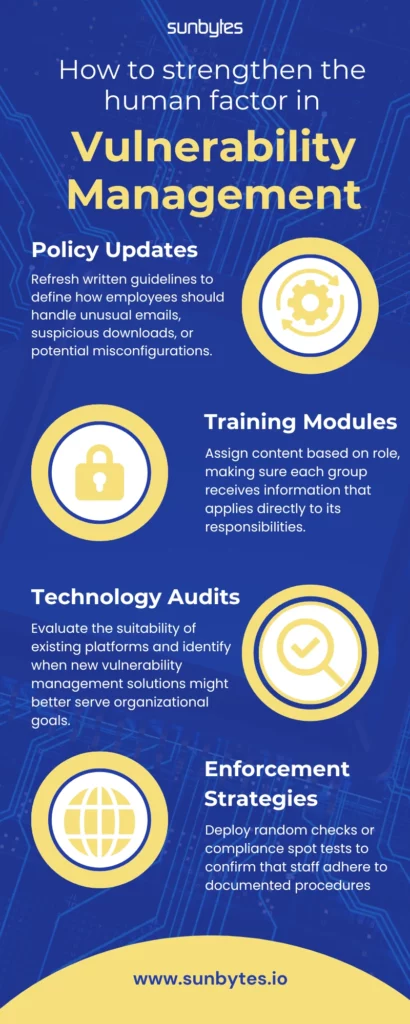Vulnerability management solutions typically revolve around software platforms and automation. Noticeably, human behavior remains a significant factor in preventing data breaches and maintaining system stability. Approximately 82% of breaches involved the human element. That is why approaches like penetration testing become the forefront of preventing breaches from happening, as they simulate real-world cyberattacks
This article reveals how organizations can address staff-driven risks, elevate skill sets, and reinforce a culture where every member, from junior employees to executive leadership, plays a substantial role in safeguarding digital assets.
How human behavior creates security gaps
Employees often introduce vulnerabilities accidentally. For instance, a well-intentioned developer might overlook a misconfiguration when deploying a web application, or an overwhelmed staff member could create a weak password for the sake of convenience. Such oversights contribute to risk exposure, regardless of how robust vulnerability management solutions appear.
Here are the most common entry points for errors:
- Misconfigurations: A firewall port left open or an insecure file-sharing protocol can create openings.
- Weak Passwords: Cybercriminals use brute-force methods on simple passwords, which continue to appear in employee credentials.
- Unintentional Data Exposure: Publicly sharing sensitive documents through links lacking adequate protection occurs more frequently than many assume.
Organizations like healthcare clinics, fintech startups, and e-commerce platforms all face these pitfalls. Recently, 569.012 patients from NorthBay Healthcare had their financial, medical, and health insurance details, as well as SSNs and passport and credit or debit card numbers, stolen following an Embargo ransomware attack against its systems, exemplifying how a seemingly trivial oversight can result in widespread consequences.
Bridging knowledge gaps: Empowering teams with the right skills and awareness
One-size-fits-all security training rarely addresses the complexity of modern threats. A single “cyber hygiene” course might teach password best practices, but it often omits the specialized tactics that advanced vulnerability management solutions require. Instead, leadership should sponsor detailed training that meets distinct departmental needs.
Regular refresher sessions keep this knowledge active. For non-technical teams, these sessions might highlight safe data-handling techniques and social engineering red flags. Meanwhile, IT personnel benefit from in-depth lessons on patch management, the use of scanning tools, and methods to validate system integrity. By segmenting training, executives and frontline workers alike build an understanding of how their actions directly shape security outcomes.


Sunbytes has completed ISO 27001 training, showcasing our commitment to building a security-first culture across every department
Instilling a Security-First culture: Building accountability and ownership
Mature cybersecurity programs depend on an organizational mindset that regards data protection as everyone’s responsibility. To achieve this outlook, leaders should introduce clear policies outlining the chain of accountability for vulnerability management solutions. This includes specifying which departments handle regular system patches, how to report suspicious activities, and what steps to take during an incident.
Visible leadership commitment remains just as vital. When C-level stakeholders publicly endorse measures, through budget commitments or staff-wide announcements, it signals that cybersecurity efforts extend beyond IT alone. Some companies recruit internal “security ambassadors” to reinforce best practices in daily operations. These representatives provide a channel for peers to ask questions, share concerns, and propose enhancements to existing policies.

Nigel, VP Security Services & Security Ambassador at Sunbytes, shares his thought after being ISO 27001 certified
Mitigating human error through technology and process alignment
Tools alone do not solve security gaps. Automated scanning and patch deployment certainly minimize manual errors, but structured processes and well-considered procedures provide the necessary checks and balances. Teams that rely on vulnerability management solutions should implement consistent protocols:
- Checklists: Clear, step-by-step lists guide staff through tasks such as app deployments, configuration updates, and security patching.
- Incident Playbooks: A standardized approach to containment and recovery can shorten the time it takes to address threats.
- Escalation Protocols: A transparent hierarchy ensures that issues are elevated to the right individuals or teams without delay.
Technological upgrades remain indispensable, yet human oversight determines how effectively these solutions function. Even the most advanced system benefits from staff who understand when automated tasks complete successfully, and when they fail, so immediate corrections can be made.
Promoting continuous improvement: Feedback loops and performance metrics
Feedback from employees reveals where vulnerability management solutions might fall short. Even minor hiccups, such as recurring false positives or unclear instructions for patching, can be addressed promptly if management welcomes open communication. Routine surveys or post-incident reviews foster a continuous improvement mindset.
Measuring outcomes also clarifies whether a security initiative has succeeded. For instance:
- Time to Detect Vulnerabilities: Shorter detection windows reduce the chance for an attacker to exploit a gap.
- Rate of Patch Compliance: A higher completion rate within mandated time frames indicates effective coordination.
- Training Completion Rates: Departments with high training compliance typically exhibit fewer risky behaviors.
Stakeholders respond more favorably to metrics that illuminate progress. If system downtime shrinks or fewer near-misses occur, executives are more likely to fund further security enhancements.
Practical steps to strengthen the human factor in vulnerability management
Cementing a stable security structure requires tangible actions and collaboration across various teams. Leaders can coordinate a comprehensive approach:
- Policy Updates: Refresh written guidelines to define how employees should handle unusual emails, suspicious downloads, or potential misconfigurations.
- Training Modules: Assign content based on role, making sure each group receives information that applies directly to its responsibilities.
- Technology Audits: Evaluate the suitability of existing platforms and identify when new vulnerability management solutions might better serve organizational goals.
- Enforcement Strategies: Deploy random checks or compliance spot tests to confirm that staff adhere to documented procedures.

IT, HR, and legal departments benefit from working together. When these groups align, they create policies that protect data while respecting compliance requirements and safeguarding employee rights. As a final step, leaders should schedule periodic reviews and audits, quarterly or biannually, to keep everyone focused on improvement.
If your organization aims to align human behavior with technology, Sunbytes’ cybersecurity service offers guidance on designing people-centered frameworks for vulnerability management solutions. Reach out today to learn how a tailored approach can protect your critical assets and support a security-minded culture.
Let’s get started with Sunbytes
Let us know your requirements for the team and we will get back to you right away.


